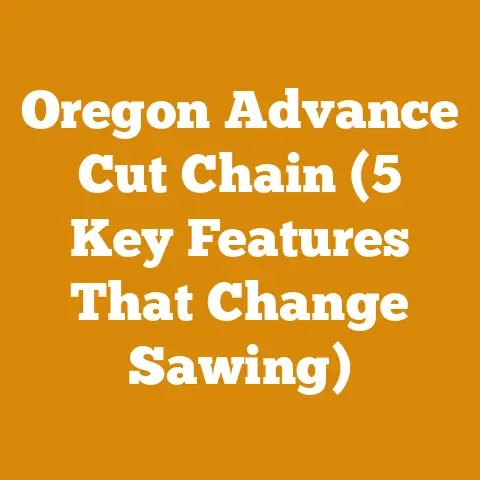Bladed Weed Eater Tips (5 Pro Tricks for Heavy Brush Cutting)
Opening with a dilemma: I can’t tell you how many times I’ve seen folks wrestling with overgrown weeds and thick brush, only to end up with a weed eater that’s spitting and sputtering, or worse, completely broken. It’s frustrating, time-consuming, and frankly, a waste of good equipment. The truth is, a standard string trimmer just isn’t designed for heavy-duty work. That’s where bladed weed eaters come in – but even with the right tool, technique is everything. I’ve spent years clearing everything from delicate garden edges to dense thickets, and I’ve learned a few tricks along the way. So, let’s dive into some pro-level techniques for tackling heavy brush with a bladed weed eater.
Bladed Weed Eater Tips: 5 Pro Tricks for Heavy Brush Cutting
1. Understanding Your Blade: Choosing the Right Weapon
The first, and arguably most crucial step, is selecting the right blade for the job. Not all blades are created equal, and using the wrong one can lead to inefficiency, damage to your equipment, or even injury. I remember one time, early in my firewood business, I tried using a thin, flimsy blade to clear some seriously dense blackberry bushes. The blade bent almost immediately, and I was lucky to escape with just a scratched hand.
What’s Available?
- Metal Blades (Brush Knives): These are your go-to for heavy brush. They come in various shapes and sizes, from two-tooth blades for thicker saplings to multi-tooth blades for general brush clearing.
- Plastic Blades: A step up from string, but still best suited for lighter vegetation. I sometimes use these around delicate flower beds to minimize the risk of damage.
- Circular Saw Blades: These are serious business and should only be used by experienced operators for cutting small trees and very thick brush. Safety is paramount.
Why It’s Important
Choosing the right blade dramatically impacts efficiency and safety. A blade designed for thick brush will cut faster and cleaner, reducing strain on both you and your weed eater. It also minimizes the risk of kickback, which can be dangerous.
How to Interpret It
Look at the blade’s design and intended use. A blade with fewer, larger teeth is generally better for cutting thicker material, while a blade with more, smaller teeth is better for lighter brush. The blade’s thickness also matters; a thicker blade will be more durable but may require a more powerful weed eater.
How It Relates to Other Metrics
Blade selection directly impacts cutting speed (time), fuel consumption (cost), and the quality of the cut (efficiency). Using the wrong blade will increase time spent on the job, use more fuel, and potentially leave behind ragged edges that require additional cleanup.
My Experience: I’ve found that a good quality, multi-tooth metal blade is the most versatile option for general brush clearing. I always keep a few different types on hand, though, so I can switch to a two-tooth blade for thicker saplings or a plastic blade for delicate areas.
2. The Power Stance: Mastering Your Body Mechanics
Proper body mechanics are essential for safe and efficient brush cutting. It’s not just about swinging the weed eater around; it’s about using your body weight and momentum to your advantage. I’ve seen folks hunching over, straining their backs, and generally making the job much harder than it needs to be.
What to Do
- Stance: Stand with your feet shoulder-width apart, knees slightly bent, and weight balanced. This provides a stable base and allows you to move freely.
- Grip: Hold the weed eater firmly with both hands, maintaining a comfortable grip. Avoid gripping too tightly, as this can lead to fatigue.
- Movement: Use your whole body to swing the weed eater, not just your arms. Rotate your torso and shift your weight to generate power.
Why It’s Important
Good body mechanics reduce fatigue, prevent injuries, and improve cutting efficiency. A stable stance allows you to maintain control of the weed eater, while using your whole body to swing reduces strain on your arms and back.
How to Interpret It
Pay attention to how your body feels while you’re working. If you’re feeling strained or uncomfortable, adjust your stance and grip. Take frequent breaks to stretch and rest.
How It Relates to Other Metrics
Proper body mechanics directly impact the amount of time you can work before becoming fatigued (time), the amount of brush you can clear in a given time (yield), and the risk of injury (safety). Working with poor body mechanics will lead to fatigue, reduced yield, and an increased risk of injury.
My Experience: I learned the importance of body mechanics the hard way. Early on, I’d try to muscle my way through thick brush, and I’d end up with a sore back and aching arms by the end of the day. Now, I focus on using my whole body to swing the weed eater, and I can work for much longer without getting tired.
3. The Art of the Swing: Techniques for Efficient Cutting
Swinging a bladed weed eater isn’t just about wildly flailing around. There’s a technique to it that maximizes efficiency and minimizes strain. It’s about understanding the blade’s cutting arc and using it to your advantage.
Techniques
- The Pendulum Swing: This is your basic cutting motion. Swing the weed eater in a smooth, arc, using the blade to slice through the brush.
- The Sweep: Use a wider arc to clear larger areas of light brush.
- The Chop: For thicker stems and saplings, use a chopping motion, bringing the blade down on the target with force.
- Layering: When dealing with very thick brush, work in layers, cutting from the top down. This prevents the blade from getting bogged down and reduces the risk of kickback.
Why It’s Important
Using the right cutting technique improves efficiency, reduces strain on the weed eater, and minimizes the risk of kickback. A smooth, controlled swing will cut faster and cleaner than a jerky, uncontrolled one.
How to Interpret It
Pay attention to how the blade is interacting with the brush. If it’s getting bogged down or kicking back, adjust your technique. Experiment with different angles and speeds to find what works best for different types of vegetation.
How It Relates to Other Metrics
Cutting technique directly impacts cutting speed (time), fuel consumption (cost), and the quality of the cut (efficiency). Using the wrong technique will increase time spent on the job, use more fuel, and potentially damage the blade or the weed eater.
My Experience: I used to just swing the weed eater back and forth as fast as I could, but I quickly learned that this wasn’t the most efficient way to work. Now, I focus on using a smooth, controlled swing, and I can clear much more brush in less time. Layering is especially important when dealing with very thick brush; it prevents the blade from getting stuck and reduces the risk of kickback.
4. Safety First: Protecting Yourself and Others
Safety is paramount when working with any power tool, especially a bladed weed eater. These things can be dangerous if not used properly. I’ve seen too many accidents, and I want to make sure you avoid them.
Safety Gear
- Eye Protection: Always wear safety glasses or a face shield to protect your eyes from flying debris.
- Hearing Protection: Weed eaters can be loud, so wear earplugs or earmuffs to protect your hearing.
- Gloves: Wear sturdy gloves to protect your hands from cuts and scratches.
- Long Pants and Sleeves: Wear long pants and sleeves to protect your skin from flying debris and thorny plants.
- Steel-Toed Boots: Wear steel-toed boots to protect your feet from injury.
Safe Practices
- Clear the Area: Before starting, clear the area of any obstacles, such as rocks, branches, or hidden objects.
- Keep Bystanders Away: Keep bystanders at least 50 feet away from the work area.
- Inspect the Equipment: Before each use, inspect the weed eater and blade for any damage.
- Never Modify the Equipment: Never modify the weed eater or blade in any way.
- Be Aware of Your Surroundings: Be aware of your surroundings at all times, and watch out for potential hazards, such as uneven terrain, slippery surfaces, or wildlife.
- Take Breaks: Take frequent breaks to avoid fatigue.
Why It’s Important
Safety is the most important consideration when working with a bladed weed eater. Following safety precautions will minimize the risk of injury to yourself and others.
How to Interpret It
Always err on the side of caution. If you’re unsure about something, stop and ask for help.
How It Relates to Other Metrics
Safety directly impacts productivity. An injury can sideline you for days or weeks, costing you time and money.
My Experience: I’ve always been a stickler for safety, and I’ve never had any serious accidents. I always wear the appropriate safety gear, and I always take the time to clear the area and inspect the equipment before starting. I also make sure to take frequent breaks to avoid fatigue.
5. Maintenance Matters: Keeping Your Equipment in Top Shape
A well-maintained weed eater is a safe and efficient weed eater. Regular maintenance will extend the life of your equipment and prevent costly repairs.
Maintenance Tasks
- Clean the Air Filter: Clean the air filter regularly to ensure proper airflow.
- Check the Spark Plug: Check the spark plug regularly and replace it if necessary.
- Sharpen the Blade: Sharpen the blade regularly to maintain its cutting edge.
- Lubricate Moving Parts: Lubricate moving parts, such as the gearbox and the throttle cable, to reduce friction.
- Check the Fuel Lines: Check the fuel lines for leaks and replace them if necessary.
- Store Properly: Store the weed eater in a dry, protected area when not in use.
Why It’s Important
Regular maintenance will keep your weed eater running smoothly and efficiently, extending its life and preventing costly repairs.
How to Interpret It
Follow the manufacturer’s recommendations for maintenance intervals.
How It Relates to Other Metrics
Maintenance directly impacts equipment downtime (time), repair costs (cost), and the overall lifespan of the weed eater (long-term investment). Neglecting maintenance will lead to increased downtime, higher repair costs, and a shorter lifespan for your equipment.
My Experience: I used to neglect maintenance, and I paid the price. My weed eater would constantly break down, and I’d end up spending a lot of time and money on repairs. Now, I make it a point to perform regular maintenance, and my weed eater runs much more smoothly and reliably. I also keep a log of all maintenance performed, which helps me track the equipment’s overall health and identify potential problems before they become serious.
Project Metrics and KPIs in Wood Processing and Firewood Preparation
While the above tips focus on the practical aspects of using a bladed weed eater, it’s important to remember that even seemingly small tasks like brush clearing can be optimized by tracking key performance indicators (KPIs) and project metrics. In the broader context of wood processing or firewood preparation, these metrics become even more crucial for efficient and profitable operations.
I’ve learned over the years that you can’t manage what you don’t measure. Just winging it might work for a small backyard project, but if you’re trying to run a business, you need data to make informed decisions.
Let’s delve into some specific metrics and KPIs that I track in my own firewood business, and how they relate to the bladed weed eater tips discussed earlier.
1. Time Per Acre Cleared (Brush Clearing Efficiency)
- Definition: This metric measures the time it takes to clear one acre of brush, typically measured in hours per acre.
- Why It’s Important: It provides a baseline for estimating labor costs and project timelines. It also helps identify areas where efficiency can be improved. For example, if the time per acre is consistently high in a certain area, it might indicate that different brush clearing techniques or equipment are needed.
- How to Interpret It: A lower time per acre indicates greater efficiency. Track this metric over time to identify trends and evaluate the effectiveness of changes to your methods.
- How It Relates to Other Metrics: This metric is closely related to fuel consumption, blade wear, and labor costs. If you can reduce the time per acre, you’ll likely also reduce fuel consumption and blade wear, leading to lower overall costs. The blade selection and cutting techniques (tips 1 and 3) directly impact this metric.
My Experience: I track the time it takes to clear brush on each property I work on. I’ve found that the time per acre can vary widely depending on the density of the brush, the type of vegetation, and the terrain. By tracking this metric, I can accurately estimate the cost of clearing brush for future projects. For instance, I recently cleared two acres of land. One acre, with light brush, took me 4 hours. The second acre, with dense thickets, took 8 hours. This data helps me price future jobs more accurately.
2. Fuel Consumption Per Hour (Equipment Efficiency)
- Definition: This metric measures the amount of fuel consumed by the weed eater per hour of operation, typically measured in gallons per hour.
- Why It’s Important: It helps identify inefficient equipment or operating practices. High fuel consumption can indicate a worn engine, a dull blade, or inefficient cutting techniques.
- How to Interpret It: A lower fuel consumption per hour indicates greater efficiency. Track this metric over time to identify trends and evaluate the effectiveness of maintenance practices.
- How It Relates to Other Metrics: This metric is closely related to time per acre cleared, blade wear, and maintenance costs. If you can reduce fuel consumption per hour, you’ll likely also reduce blade wear and maintenance costs, leading to lower overall costs. Proper maintenance (tip 5) is crucial for optimizing this metric.
My Experience: I meticulously track the fuel consumption of all my equipment. I discovered that one of my weed eaters was consuming significantly more fuel than the others. After a thorough inspection, I found that the air filter was clogged. Cleaning the air filter significantly improved fuel efficiency. Now, I make sure to clean the air filter regularly as part of my maintenance routine. I also switched to a higher-quality fuel, which further improved fuel efficiency. This simple change saved me a significant amount of money over the course of a year.
3. Blade Wear and Replacement Rate (Tool Durability)
- Definition: This metric measures the number of blades used per unit of time or per unit of area cleared. It can be expressed as blades per month or blades per acre.
- Why It’s Important: It helps identify blades that are not durable enough for the type of brush being cleared, or operating practices that are causing excessive blade wear.
- How to Interpret It: A lower blade wear and replacement rate indicates greater durability and efficiency. Track this metric over time to compare the performance of different blade types and evaluate the effectiveness of cutting techniques.
- How It Relates to Other Metrics: This metric is closely related to time per acre cleared, fuel consumption, and maintenance costs. Using the wrong blade for the job (tip 1) will lead to increased blade wear and replacement rate.
My Experience: I experimented with different types of blades to find the ones that were most durable and efficient for the type of brush I typically clear. I found that some blades were much more prone to bending or breaking than others. By tracking the blade wear and replacement rate, I was able to identify the blades that provided the best value for my money. I also realized that my cutting technique was contributing to excessive blade wear. By focusing on using a smoother, more controlled swing (tip 3), I was able to significantly reduce blade wear and extend the life of my blades.
4. Labor Costs Per Acre (Operational Expense)
- Definition: This metric measures the total labor cost associated with clearing one acre of brush, typically measured in dollars per acre.
- Why It’s Important: It provides a clear picture of the labor costs associated with brush clearing. High labor costs can indicate inefficient operating practices or the need for more efficient equipment.
- How to Interpret It: A lower labor cost per acre indicates greater efficiency. Track this metric over time to identify trends and evaluate the effectiveness of changes to your methods.
- How It Relates to Other Metrics: This metric is closely related to time per acre cleared, fuel consumption, and blade wear. Improving efficiency in any of these areas will lead to lower labor costs. Proper body mechanics (tip 2) and efficient cutting techniques (tip 3) are crucial for optimizing this metric.
My Experience: I carefully track my labor costs for each project. I’ve found that labor costs can vary widely depending on the complexity of the job and the skill of the worker. By tracking this metric, I can accurately estimate the labor costs for future projects and identify areas where I can improve efficiency. I also incentivize my workers to find ways to reduce labor costs, such as by using more efficient equipment or developing new cutting techniques.
5. Downtime Due to Equipment Failure (Operational Reliability)
- Definition: This metric measures the amount of time that equipment is out of service due to breakdowns or repairs, typically measured in hours per month.
- Why It’s Important: It provides a measure of the reliability of your equipment. High downtime can indicate poor maintenance practices or the need for more durable equipment.
- How to Interpret It: A lower downtime indicates greater reliability. Track this metric over time to identify trends and evaluate the effectiveness of maintenance practices.
- How It Relates to Other Metrics: This metric is closely related to maintenance costs, fuel consumption, and blade wear. Regular maintenance (tip 5) is crucial for minimizing downtime.
My Experience: I keep a detailed log of all equipment maintenance and repairs. I’ve found that certain types of equipment are more prone to breakdowns than others. By tracking downtime, I can identify potential problems before they become serious and take steps to prevent them. I also make sure to train my workers on proper equipment operation and maintenance procedures. This has significantly reduced downtime and improved the overall reliability of my equipment.
6. Wood Volume Yield Efficiency (Firewood Specific)
- Definition: This metric measures the amount of usable firewood obtained from a given volume of raw wood, typically expressed as a percentage.
- Why It’s Important: It reflects how effectively you are converting raw materials into a sellable product. High efficiency means less waste and more profit.
- How to Interpret It: A higher percentage indicates better yield efficiency. Factors influencing this include the species of wood, the cutting techniques used, and the amount of waste generated.
- How It Relates to Other Metrics: This is closely tied to labor costs, as efficient cutting can reduce the time spent processing wood. It also relates to waste management costs, as lower yield efficiency means more waste to dispose of.
My Experience: I noticed a significant difference in yield efficiency between different wood species. Hardwoods like oak and maple consistently produced higher yields than softer woods like pine. I also realized that my cutting techniques were contributing to waste. By optimizing my cutting patterns and minimizing the amount of wood lost to sawdust, I was able to significantly improve my yield efficiency. This translated directly into increased profits.
7. Firewood Moisture Content Levels (Quality Control)
- Definition: This metric measures the percentage of water content in firewood.
- Why It’s Important: Properly seasoned firewood (low moisture content) burns more efficiently and produces less smoke. Selling firewood with high moisture content can damage your reputation and lead to customer complaints.
- How to Interpret It: Firewood should ideally have a moisture content below 20%. Use a moisture meter to regularly check the moisture content of your firewood.
- How It Relates to Other Metrics: Drying time is directly related to moisture content. Factors like wood species, stacking method, and weather conditions influence drying time. This also affects customer satisfaction and repeat business.
My Experience: I invested in a good quality moisture meter and made it a standard part of my firewood preparation process. I discovered that the drying time for firewood varied significantly depending on the weather conditions. During periods of high humidity, the drying time was much longer. I also experimented with different stacking methods to find the ones that promoted the best airflow and accelerated drying. By consistently monitoring the moisture content of my firewood, I was able to ensure that I was selling a high-quality product that met my customers’ expectations.
8. Customer Satisfaction Rate (Business Sustainability)
- Definition: This metric measures how satisfied customers are with your products and services.
- Why It’s Important: Happy customers are more likely to become repeat customers and recommend your business to others.
- How to Interpret It: Use surveys, reviews, and feedback forms to gauge customer satisfaction. Track this metric over time to identify trends and address any issues.
- How It Relates to Other Metrics: This metric is directly related to the quality of your firewood, the efficiency of your service, and the value you provide. Delivering high-quality firewood with low moisture content and providing prompt, reliable service will lead to higher customer satisfaction.
My Experience: I regularly solicit feedback from my customers to gauge their satisfaction. I use a simple online survey to ask customers about their experience with my firewood and my service. I also encourage customers to leave reviews on my website and on social media. By carefully monitoring customer feedback, I’ve been able to identify areas where I can improve my business and better meet my customers’ needs. I also offer a satisfaction guarantee, which gives customers peace of mind and encourages them to try my firewood.
Applying These Metrics to Improve Future Projects
The key to success in wood processing and firewood preparation is continuous improvement. By tracking these metrics and analyzing the data, you can identify areas where you can improve efficiency, reduce costs, and increase customer satisfaction.
Here are some specific steps you can take to apply these metrics to improve future projects:






